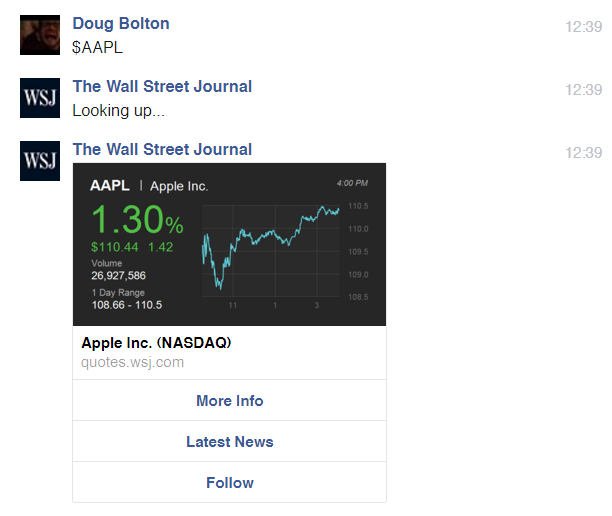Facebook Messenger chatbots: How do you use them?
Facebook's bots are coming - but humans shouldn't be worried about their jobs just yet

Your support helps us to tell the story
From reproductive rights to climate change to Big Tech, The Independent is on the ground when the story is developing. Whether it's investigating the financials of Elon Musk's pro-Trump PAC or producing our latest documentary, 'The A Word', which shines a light on the American women fighting for reproductive rights, we know how important it is to parse out the facts from the messaging.
At such a critical moment in US history, we need reporters on the ground. Your donation allows us to keep sending journalists to speak to both sides of the story.
The Independent is trusted by Americans across the entire political spectrum. And unlike many other quality news outlets, we choose not to lock Americans out of our reporting and analysis with paywalls. We believe quality journalism should be available to everyone, paid for by those who can afford it.
Your support makes all the difference.Facebook has begun rolling out its new chatbot platform on Messenger, and it's available to try out right now.
The long-awaited 'Bot Platform' was unveiled by Facebook CEO Mark Zuckerberg on the first day of the F8 developer conference, and the company hopes it's going to change the way we all use the web.
Rather than browsing the latest news, communicating with businesses and buying goods through standard sites and apps, Facebook's bots make it possible to do it all through Messenger - theoretically, you should be able to get what you're looking for by speaking to the bots in natural language.
But do they work? The platform is currently the beta stage and it's only working with a few US-based companies. But it's already possible to get a little taste of what this technology can do.
The Wall Street Journal
The WSJ is one of a handful of media organisations already using the bots.
By going to the paper's Facebook page, or visiting their chatbot page directly, you can get updates on news and the financial markets.

Typing 'top news' brings you a quick slideshow of headlines which you can click on to read the full story, which would possibly be useful if you wanted a quick update on the news on the go.
You can also ask it about how certain companies are performing. By entering the company's ticker code with a dollar sign prefix, you get a graph of its performance. So sending a '$AAPL' message brings you Apple's recent stock prices.

You can also compare companies side-by-side, and check on the state of your portfolio - it's maybe a niche tool, but it could possibly be handy for financial types.
1-800-Flowers
This US-based florist was used as one of the bot demonstrations at F8.

By starting a conversation with the company from the Messenger app or their desktop Facebook page, you can choose a bouquet, select the right delivery address, include a note and pay for everything - however, the service is only currently available in the US.
Again, it's interesting to see it in action, and chatting with the bot is a little quicker than filling out the details on a regular site, especially on mobile.
Spring
Spring is an American clothes retailer which has been an early adopter of the bot platform - by chatting with the company on Facebook, you can browse different items, choose your price range and see related purchases. However, when you actually want to buy something, it takes you to the full website - making the whole chat aspect a bit redundant.

CNN and weather app Poncho are other companies currently using the platform, and can deliver mini-updates to a user's inbox at a pre-set time.
One of the most interesting uses of the technology, however, is Detective Kees: Probable Cause - a kind of text-based murder mystery game, in which the user chats with a fictional detective to solve crimes.
Overall, the bot platform has some way to go before it becomes useful enough to replace typical websites. Using a chatbot to order clothes or flowers gets rid of the need to fill out endless boxes and navigate numerous checkout pages, but they're just not that smart yet - sometimes, when you're struggling with getting the AI to understand you, the experience is similar to using one of those automated cinema ticket phone lines.
However, the platform is still in its beta stages, and eventually the bots will get better at understanding natural human language.
The technology looks promising, but it'll take time to improve. Humans probably shouldn't start worrying about their jobs just yet.
Join our commenting forum
Join thought-provoking conversations, follow other Independent readers and see their replies
Comments